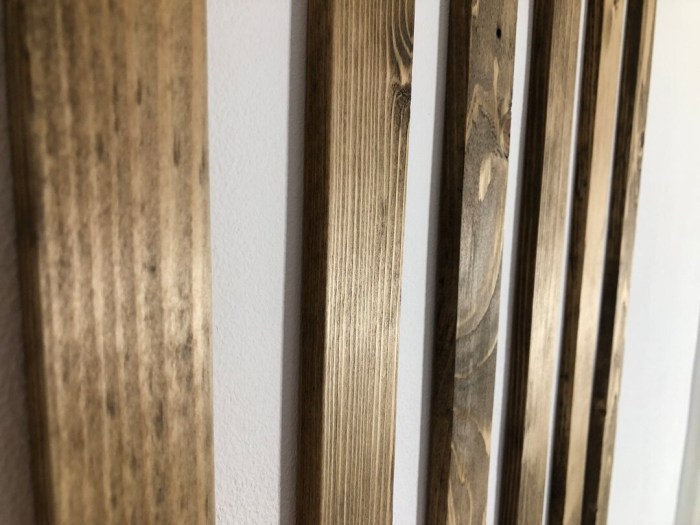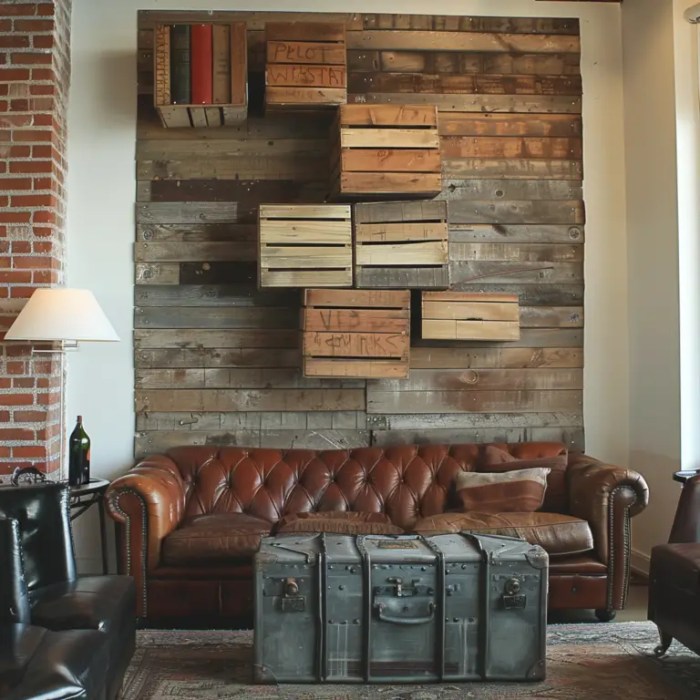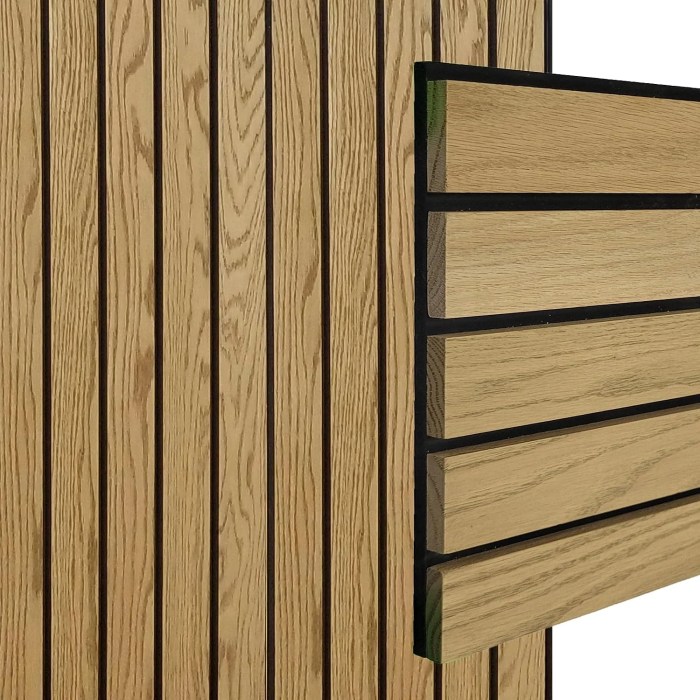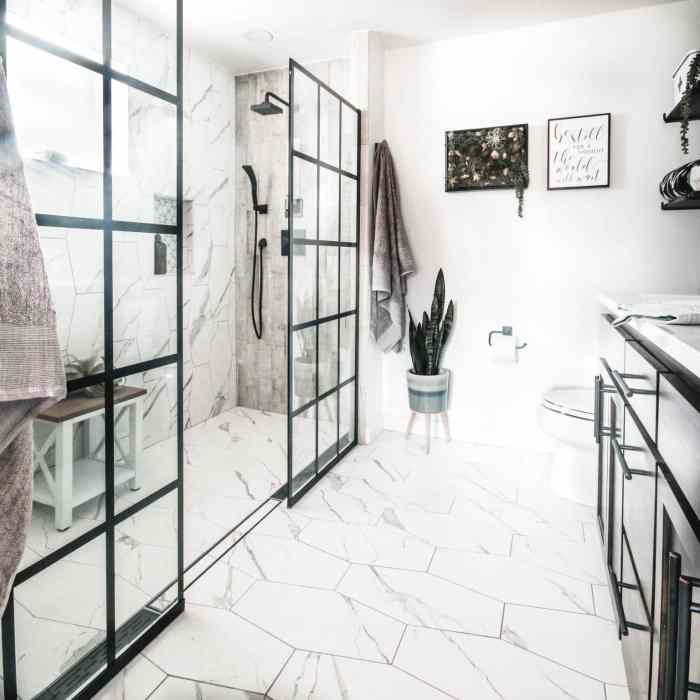Wood Slat Decorative Walls A Comprehensive Guide
Wood slat decorative walls offer a unique aesthetic appeal, blending natural beauty with versatility. This comprehensive guide explores the various aspects of wood slat decorative walls, from the different types of wood and finishes to installation, maintenance, and design ideas. We’ll delve into the pros and cons, styles, and applications, ensuring a thorough understanding of this captivating wall treatment.
Understanding the different types of wood used, such as pine, cedar, and oak, is crucial to selecting the right material for your project. Each wood type has distinct characteristics impacting the overall aesthetic and longevity of the wall. The choice of finish, whether stained, painted, or left natural, also significantly influences the visual impact and maintenance requirements. We’ll also explore different installation methods and discuss the importance of proper measurements to ensure a seamless installation.
Introduction to Wood Slat Decorative Walls

Source: etsystatic.com
Wood slat decorative walls are a popular choice for interior design, offering a natural aesthetic and versatility. They consist of horizontal wooden slats arranged to create a visually appealing and textured surface. This approach can transform a room, adding warmth and character to any space.
These walls are constructed from various types of wood, each with its own unique properties and visual characteristics. The choice of wood often depends on the desired aesthetic and budget. Different finishes and treatments further enhance the overall look and feel of the wall.
Types of Wood
A wide variety of wood types are suitable for slat walls. Pine, known for its affordability, is a common choice for budget-conscious projects. Cedar, with its natural resistance to rot and insects, is ideal for outdoor applications or areas with high humidity. Oak, with its rich grain and durability, is often favored for its sophisticated appearance and longevity. Other woods like maple or walnut can also be used, each offering a unique aesthetic and performance characteristic.
Finishes and Treatments
The aesthetic appeal of wood slat walls can be significantly enhanced by various finishes and treatments. Natural wood, showcasing the raw beauty of the grain, is a popular choice. Staining adds depth and color, allowing customization to match the overall room décor. Painting offers a versatile option for creating a more contemporary or specific color scheme. Other treatments like waxing or sealing can protect the wood and enhance its luster.
Pros and Cons of Wood Slat Walls
| Feature | Pros | Cons |
|---|---|---|
| Aesthetics | Adds a natural, warm, and textured element to a space. Offers a customizable aesthetic through different wood types, finishes, and slat arrangements. | Can appear rustic or dated if not styled appropriately. The natural wood grain may not be ideal for every design aesthetic. |
| Durability | Depending on the wood type, slat walls can be quite durable, withstanding daily wear and tear. Proper sealing and finishing further enhance the lifespan of the wood. | Susceptible to damage from moisture and pests if not properly treated. Wood can warp or crack if exposed to extreme temperatures or humidity fluctuations. |
| Maintenance | Regular cleaning and occasional touch-ups are usually sufficient. Finishes like stains and paints can help maintain the wall’s appearance and protect the wood from elements. | Requires consistent upkeep to prevent damage and maintain its aesthetic appeal. Maintenance efforts may increase if the wood is not sealed or finished properly. |
| Cost | The cost varies significantly depending on the type of wood, the size of the project, and the complexity of the design. Pine is generally the most affordable option. | Can be more expensive than other wall coverings, especially if high-quality, durable woods are chosen. Labor costs for installation can also add to the overall project cost. |
Styles and Applications
Wood slat walls offer a versatile design element, seamlessly integrating into various aesthetic styles and room functions. Their adaptability allows for a wide range of applications, from creating a rustic farmhouse ambiance to a contemporary, minimalist feel. The natural beauty of wood, combined with the customizable nature of slat arrangements, empowers homeowners and designers to tailor the visual impact to their specific needs.
Different design styles leverage wood slat walls to achieve distinct moods. Careful selection of wood type, slat width, and spacing significantly influences the overall look and feel.
Design Styles
Various design styles effectively utilize wood slat walls. Farmhouse designs often feature wide, slightly irregular slats in natural wood tones, evoking a warm and inviting atmosphere. Modern aesthetics frequently employ narrow, uniformly spaced slats, offering a clean and minimalist look. Rustic designs incorporate reclaimed or weathered wood, accentuating the raw, natural charm of the material. These different styles highlight the adaptable nature of wood slat walls.
Room Applications
Wood slat walls are suitable for a range of interior spaces. In living rooms, they can serve as a focal point, adding texture and depth to the overall design. Bedrooms benefit from wood slat walls by introducing a calming, natural element, enhancing the sense of tranquility. Kitchens can incorporate wood slat walls to create a rustic, warm atmosphere, while complementing the existing cabinetry and countertops.
Commercial Applications
Commercial spaces can also leverage the versatility of wood slat walls. Restaurants and cafes can use them to establish a unique ambiance, complementing the overall dining experience. Retail stores can employ them to create a distinctive visual identity, showcasing products effectively. Offices can use them to inject natural elements into the work environment, fostering a more calming atmosphere.
Visual Effects of Slat Variations
The visual impact of wood slat walls is highly dependent on the dimensions of the slats and the spacing between them. Wider slats with generous spacing create a more rustic and open feel. Narrower slats with closer spacing lend a more refined and contemporary aesthetic. The varying textures of the wood itself, such as knots and grain patterns, also contribute to the overall visual effect.
Slat Arrangement Comparisons
The arrangement of slats significantly influences the overall visual impact. Different arrangements create distinct visual effects and are suitable for various rooms.
| Arrangement | Visual Effect | Potential Rooms |
|---|---|---|
| Vertical | Creates a tall, narrow, and visually elongated space. Can emphasize height in rooms with low ceilings. | Living rooms, hallways, bedrooms, and offices |
| Horizontal | Emphasizes the width of the room. Suitable for creating a sense of spaciousness. | Living rooms, dining rooms, kitchens, and entryways |
| Diagonal | Adds a dynamic and eye-catching element. Can create a sense of movement and depth. | Living rooms, bedrooms, and hallways. Can be particularly effective in smaller spaces. |
Installation and Construction

Source: dreamyhomestyle.com
Installing a wood slat wall requires careful planning and execution to achieve a professional-looking finish. Precise measurements and appropriate mounting methods are crucial for a durable and aesthetically pleasing result. This section details the steps involved, the necessary tools and materials, and key considerations for a seamless installation.
Step-by-Step Installation
This process Artikels the fundamental steps for installing a wood slat wall. Begin by thoroughly preparing the wall surface, ensuring it’s clean and stable. Mark the desired placement of the slats using a level and pencil. Attach the slats to the wall using the chosen mounting method, ensuring even spacing and alignment. Finally, inspect the completed wall for any imperfections and make necessary adjustments.
Required Tools and Materials
Proper tools and materials are essential for a successful installation. A comprehensive toolkit should include measuring tools, cutting tools, and fastening hardware. Appropriate wood slats, suitable for the intended wall space, are crucial. The selection of mounting hardware (nails, screws, or adhesive) will depend on the chosen installation method and the characteristics of the wood.
Measuring and Cutting Wood Slats
Accurate measurements are paramount for achieving a precise fit. Measure the wall space where the slats will be installed, accounting for the desired spacing between slats. Use a measuring tape and pencil to mark the cutting lines on the wood slats. Employ a saw, preferably a miter saw for straight cuts, to carefully cut the slats to the measured dimensions. Precise cutting ensures a seamless and aesthetically pleasing final result.
Mounting Methods
Different mounting methods offer varying levels of stability and aesthetic appeal. Nails provide a traditional look, while screws offer greater strength and security. Adhesive methods offer a clean, modern look and are ideal for certain types of wood. The choice of method should be based on the type of wood, the wall material, and the desired level of durability.
Creating a Seamless Installation
Achieving a seamless installation involves careful attention to detail at each step. Start by ensuring the wall surface is prepared properly. Maintain consistent spacing between slats using spacers. Pay close attention to alignment and level, using a level to ensure a straight line. Apply pressure evenly during installation to ensure secure fastening. Inspect the installation for any gaps or inconsistencies and make adjustments as needed.
Tools and Materials Table
| Tool/Material | Description | Quantity |
|—|—|—|
| Measuring Tape | For accurate measurements | 1 |
| Pencil | For marking cutting lines | 1 |
| Miter Saw or Hand Saw | For cutting wood slats | 1 |
| Level | For ensuring straight lines | 1 |
| Wood Slats | Pre-cut or pre-measured lumber | As needed |
| Nails/Screws | For securing the slats | As needed |
| Wood Glue or Adhesive | For additional strength (optional) | As needed |
| Spacers | For maintaining consistent spacing | As needed |
| Drill | For driving screws | 1 |
| Drill Bits | Matching screw sizes | As needed |
| Safety Glasses | For eye protection | 1 pair |
| Work Gloves | For hand protection | 1 pair |
Maintenance and Care
Wood slat decorative walls, while visually appealing, require consistent maintenance to retain their aesthetic value and longevity. Proper care prevents premature deterioration, ensuring the wall’s beauty and functionality for years to come. This section details the regular maintenance practices, cleaning procedures, repair techniques, and preventative measures to safeguard these walls from damage.
Maintaining a wood slat wall involves a multifaceted approach, focusing on regular cleaning, preventative measures against moisture and pests, and prompt action for any minor damage. This meticulous care ensures the wall’s pristine appearance and structural integrity.
Regular Cleaning Methods
Regular cleaning is crucial for preserving the finish and preventing the accumulation of dirt, grime, and other contaminants. The specific cleaning methods depend heavily on the type of finish applied to the slats.
- For Stained or Painted Wood: Use a soft-bristled brush or a microfiber cloth dampened with a mild soap solution. Avoid harsh chemicals or abrasive cleaners, which can damage the finish. Rinse thoroughly and allow the wall to dry completely before touching.
- For Oiled Wood: Use a soft cloth or brush to wipe down the surface. For tougher dirt, use a solution of warm water and mild dish soap, but avoid excessive moisture. Ensure the surface is completely dry before allowing any contact with it.
- For Sealed Wood: Sealed wood typically requires less frequent cleaning. Use a soft, dry cloth to wipe away dust and debris. If necessary, use a damp cloth with a mild soap solution. Thoroughly dry the surface to prevent water spots or staining.
Addressing Minor Damage
Minor damage to wood slat walls, such as scratches or small dents, can be addressed promptly to prevent further deterioration.
- Scratches: For minor scratches, try using wood filler or a touch-up paint to match the existing finish. Sand the area lightly before applying the filler or paint. For deeper scratches, consider professional repair.
- Dents: Small dents can sometimes be gently pressed out with a damp cloth. For more substantial dents, consult a professional woodworker to assess the extent of the damage and provide appropriate repair solutions.
Preventing Moisture Damage and Pest Infestations
Protecting wood slat walls from moisture damage and pest infestations is vital for their long-term preservation.
- Moisture Prevention: Regularly inspect the wall for signs of water damage, such as warping or discoloration. Ensure proper ventilation in the area to prevent moisture buildup. If water damage occurs, address the source promptly and dry the affected area completely.
- Pest Control: Inspect the wall periodically for signs of pest activity, such as droppings or holes. Use appropriate pest control measures to eliminate any infestations. Consider preventative measures like sealing cracks or crevices to prevent pests from entering.
Cleaning Product Recommendations
Use appropriate cleaning products for different finishes.
- Mild Dish Soap: Effective for general cleaning of various finishes, including oil-based finishes.
- Warm Water: Use warm water for cleaning to ensure thorough cleaning and effective rinsing.
- Microfiber Cloths: Ideal for cleaning painted or stained wood, avoiding scratches and effectively absorbing moisture.
- Wood Filler/Touch-Up Paint: For minor scratches and repairs, matching the existing finish.
Potential Problems and Solutions
This table Artikels potential problems, their possible causes, and corresponding solutions.
| Problem | Potential Causes | Solutions |
|---|---|---|
| Warping | Moisture exposure, uneven drying | Address moisture source, ensure even drying, professional repair if severe |
| Fading | Sunlight exposure, improper sealant | Apply a sealant, move wall away from direct sunlight, consider re-staining/painting |
| Pest Infestation | Presence of food sources, cracks in the wall | Eliminate food sources, seal cracks, professional pest control |
| Peeling Paint | Poor preparation before painting, incompatible paint | Remove damaged paint, prep the surface properly, apply compatible paint |
Cost and Budget Considerations: Wood Slat Decorative Wall
Wood slat walls, while visually appealing, can vary significantly in cost depending on several factors. Understanding these elements is crucial for creating a realistic budget and avoiding surprises during the installation process. Careful planning and meticulous cost analysis are essential to ensure the project stays within budget and delivers the desired aesthetic.
Factors Influencing Cost
Several key factors contribute to the overall cost of a wood slat wall installation. The type of wood chosen, its quality and treatment, the size and complexity of the wall, labor costs in the area, and any additional design elements all play a role. Furthermore, the complexity of the installation, including the need for specialized tools or techniques, directly affects the overall price. For example, a large-scale project with intricate designs will invariably command a higher price tag compared to a straightforward, smaller installation.
Estimated Costs for Different Projects
Providing precise cost estimates for wood slat walls is challenging due to the many variables involved. However, a general guideline can be provided. A small, simple project, covering a relatively small area, might cost anywhere from $500 to $2,000. Projects encompassing a larger area or featuring more intricate designs, specialized wood types, or custom features could range from $2,000 to $10,000 or more. It’s vital to remember these are approximate figures and actual costs can vary based on individual circumstances.
Creating a Detailed Budget
A detailed budget is crucial for a successful wood slat wall installation. Start by determining the exact dimensions of the wall area. Next, research local labor rates for similar projects. Then, procure quotes from multiple contractors or installers. Include material costs, which will vary significantly based on wood type, grade, and finish. Consider potential permits, which may be required in certain jurisdictions. Accurately calculating all these factors will give you a comprehensive understanding of the total cost. Finally, account for contingency funds for unforeseen circumstances, which is always a good practice.
Comparison to Other Wall Covering Options
Compared to other wall covering options, wood slat walls often fall within a mid-range price bracket. Solid paneling, for instance, might be less expensive, while more luxurious materials like marble or custom-designed wallpaper will generally be more costly. However, wood slat walls offer a unique aesthetic appeal that some homeowners might find invaluable, justifying a higher price tag.
Cost Estimations for Various Wall Sizes
| Wall Size (sq ft) | Estimated Cost ($) |
|---|---|
| 50 | $1,000 – $2,000 |
| 100 | $2,000 – $4,000 |
| 150 | $3,000 – $6,000 |
| 200 | $4,000 – $8,000 |
This table provides a basic framework for estimating costs. Remember that these are only approximate figures, and actual costs will vary based on the specific materials, labor rates, and project complexities. Detailed quotes from contractors are essential for accurate budgeting.
Creative Design Ideas

Source: suite101.com
Wood slat walls offer a versatile canvas for creative expression. Their inherent texture and natural beauty can be seamlessly integrated into various design styles, from rustic to contemporary. Careful consideration of lighting, artwork, and complementary materials can elevate the aesthetic appeal and functionality of a room.
Innovative design approaches can transform a simple slat wall into a captivating focal point. By thoughtfully selecting materials and integrating lighting, you can craft a unique ambiance that resonates with the desired aesthetic.
Focal Point Design
A wood slat wall can effectively act as a focal point in a room. Strategic placement, coupled with appropriate lighting and complementary décor, can draw the eye and create a dynamic visual interest. Consider using a different wood tone or finish for the focal wall to contrast with the surrounding décor.
Combining with Lighting, Wood slat decorative wall
Lighting plays a crucial role in accentuating the natural beauty of wood slat walls. Different lighting techniques can create varied moods and highlight the unique textures. Recessed lighting, strategically placed spotlights, or ambient lighting can all contribute to the overall ambiance. Warm-toned lights will enhance the wood’s natural color, while cooler tones can create a more modern aesthetic. The choice of lighting should complement the overall design scheme of the room.
Integration with Other Materials
Integrating wood slat walls with other materials allows for a more comprehensive and layered design. Stone, tile, or metal accents can add depth and visual interest, creating a cohesive and sophisticated look. For example, a stone fireplace mantel, tile backsplash, or metal shelving unit can harmonize beautifully with a wood slat wall. The choice of material should be carefully considered to complement the wood’s texture and tone.
Creative Design Ideas Table
| Idea | Materials | Room |
|---|---|---|
| Rustic Cabin Retreat | Light-toned pine slats, reclaimed wood accents, woven baskets | Living Room, Bedroom |
| Modern Minimalist Loft | Dark stained oak slats, sleek metal accents, abstract artwork | Living Room, Dining Room |
| Coastal Coastal Farmhouse | Light gray stained cedar slats, whitewashed shiplap, seashell accents | Living Room, Dining Room |
| Bohemian Chic | Natural-toned bamboo slats, macrame wall hangings, colorful textiles | Living Room, Bedroom |
| Industrial Chic | Dark stained or painted black wood slats, exposed brick, metal shelving | Living Room, Office |
Last Recap
In conclusion, wood slat decorative walls provide a dynamic and personalized touch to any space, offering a blend of natural beauty and design flexibility. From the initial selection of wood type and finish to the final installation and maintenance, this guide has equipped you with the knowledge to confidently create a stunning wood slat wall. The diverse design possibilities and adaptable nature of these walls make them an excellent choice for a wide range of residential and commercial settings. Remember to carefully consider the pros and cons, style preferences, and budget constraints before embarking on this project.





